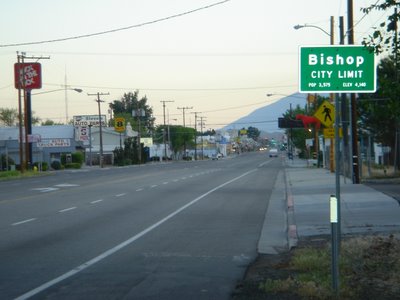
The town...Bishop, CA. Many fisherman stay here to fish in the numerous lakes that surround the area. The temperature in Bishop was 90 degrees during my stay there.
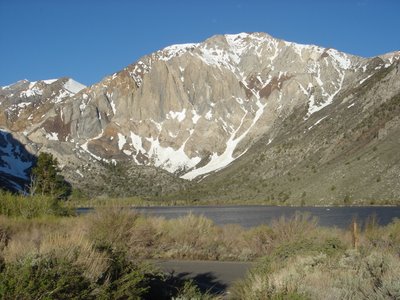 The setting...Convict Lake (7,621 feet) and Laurel Mountain (11,812 feet). The lake is approximately 35 miles northwest of Bishop. Temperatures reached into the lower 70s. What a beautiful day!
The setting...Convict Lake (7,621 feet) and Laurel Mountain (11,812 feet). The lake is approximately 35 miles northwest of Bishop. Temperatures reached into the lower 70s. What a beautiful day!
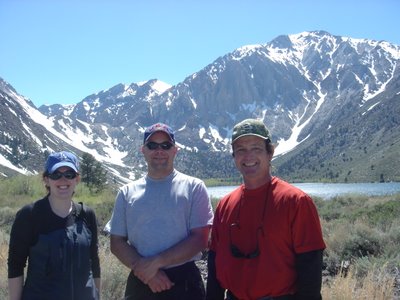 The students...Kristine, Dan and me. Dan hails from San Diego and is an auto technician for an automobile dealership. He will attempt to summit Mt. Whitney this year in mid-August for the very first time. Kristine, who is from Los Angeles, is self-employed and plans on climbing Mt. Rainier (14,410 feet) in Washington state and climbing three of the infamous 7 summits: Aconcagua (22,841 feet) in South America, Kilimanjaro (19,340 feet) in Africa, and Mt. McKinley (20,320 feet).
The students...Kristine, Dan and me. Dan hails from San Diego and is an auto technician for an automobile dealership. He will attempt to summit Mt. Whitney this year in mid-August for the very first time. Kristine, who is from Los Angeles, is self-employed and plans on climbing Mt. Rainier (14,410 feet) in Washington state and climbing three of the infamous 7 summits: Aconcagua (22,841 feet) in South America, Kilimanjaro (19,340 feet) in Africa, and Mt. McKinley (20,320 feet).
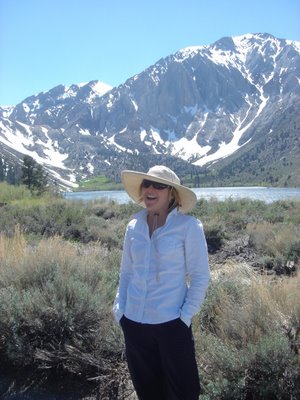 Our instructor...Ann. She received her outdoor education credentials at Prescott College in Prescott, Arizona where she obtained a Bachelor of Arts degree in Environmental Education in May 1998. She works as a mountain guide specializing in rock climbing, backpacking, and mountaineering. She is also an expert avalanche instructor. Ann has experience both professionally and recreationally in mountain ranges throughout the western United States. She is proud to call Bishop her home. When not guiding, Ann’s passions include climbing long alpine routes in the Sierra, backcountry skiing, and rock climbing.
Our instructor...Ann. She received her outdoor education credentials at Prescott College in Prescott, Arizona where she obtained a Bachelor of Arts degree in Environmental Education in May 1998. She works as a mountain guide specializing in rock climbing, backpacking, and mountaineering. She is also an expert avalanche instructor. Ann has experience both professionally and recreationally in mountain ranges throughout the western United States. She is proud to call Bishop her home. When not guiding, Ann’s passions include climbing long alpine routes in the Sierra, backcountry skiing, and rock climbing.
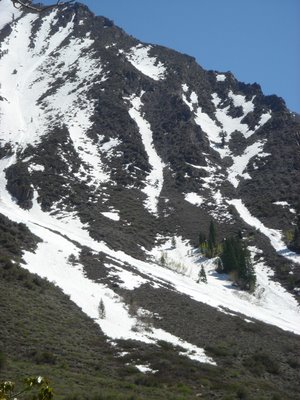
The classroom...was an avalanche chute (the long one in the back from left to right). The school covered the basics of travel on snow. Many trips in the Sierra require traveling on snow, from peak ascents to backpacking journeys routed over passes along the Sierra Crest. Many passes are over 12,000 feet and snow can stay at these elevations through the middle of summer. Techniques practiced included use of an ice axe, efficient methods for walking up and down on snow, cramponing skills, travel roped together with other people, and belaying on snow. This course provided practical knowledge applicable to climbing snow covered peaks throughout the year or during backcountry adventures during the summer months with an occasional snowfield to negotiate.
One of the things we learned was how to stop from sliding down a slope using the ice axe (self-arrest). Imagine yourself lying on your back-head first sliding down and then learning how to turn over and stop yourself from sliding off into the lake. Scary at first because of the position you are in. Once you sit down with your back to the lake you start to slide. You had to make footholds with the heel of your boots. Then you lifted you feet and away you went. Once you were able to self-arrest, it wasn’t all that bad just a little different.
The other self-arrest techniques we practiced were the seated-feet first and stomach-head first. Going stomach-head first was a rush, too. After two tries, I went into a "running start" mode while yelling, "FALLING!" I flew into the air, landed on my belly, slid for 20 feet and self-arrested with plenty of room to spare from the edge of the lake.
We had to practice using both our left and right hand sides.
We also practiced self-arrest using just our elbows. This technique is only recommended for freeze-melt (soft abrasive snow) and NOT ON ICE!
Snow travel is an art, a science, and an exercise. Going up and down this slope took a lot out of me. Extreme physical exertion of walking up snow mixed in with some high altitude was definitely a workout.
I had fun.
 The antennae farm on top of Mt. Wilson. There are also observatories up here as well.
The antennae farm on top of Mt. Wilson. There are also observatories up here as well. The Mt. Wilson Trail. This 7-mile (or 7.5 if you prefer) takes you to the summit of Mt. Wilson (5,680 feet). This trail has an elevation change of 4,710 feet (approximately 780 feet per mile). It took 4 hours to reach the top and 3 hours to get back down. Overcast conditions ruled the day. Poison oak and ceanothus lined the upper and narrower sections of the trail. There was some scrambling along one portion of the trail as well as a couple of stream crossings. This was the most strenuous hike I have ever hiked in the San Gabriels. It felt like I hiked the 22-mile Mt. Whitney Trail minus the altitude (elevation change per mile is 572 feet).
The Mt. Wilson Trail. This 7-mile (or 7.5 if you prefer) takes you to the summit of Mt. Wilson (5,680 feet). This trail has an elevation change of 4,710 feet (approximately 780 feet per mile). It took 4 hours to reach the top and 3 hours to get back down. Overcast conditions ruled the day. Poison oak and ceanothus lined the upper and narrower sections of the trail. There was some scrambling along one portion of the trail as well as a couple of stream crossings. This was the most strenuous hike I have ever hiked in the San Gabriels. It felt like I hiked the 22-mile Mt. Whitney Trail minus the altitude (elevation change per mile is 572 feet). The "Bruins" -- Dave and Jane. They live next to the San Gabriel Mountains and know the area very well. They will be going to Mt. Whitney on August 11 for a day-hike. It will be their first summit attempt. They shouldn't have any problems making it to the top.
The "Bruins" -- Dave and Jane. They live next to the San Gabriel Mountains and know the area very well. They will be going to Mt. Whitney on August 11 for a day-hike. It will be their first summit attempt. They shouldn't have any problems making it to the top.





